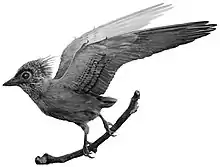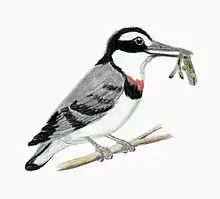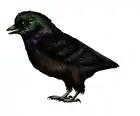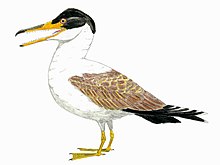Soroavisaurus
Soroavisaurus is a genus of enantiornithean birds related to Avisaurus. It lived during the Late Cretaceous of Argentina. The only known species, S. australis, is known from fossils collected from the Lecho Formation (Maastrichtian age) of Estancia El Brete, in the southern tip of the province of Salta, Argentina. A binominal name of this animal means "Southern sister Avisaur".[1]
| Soroavisaurus Temporal range: Maastrichtian ~ | |
|---|---|
| Scientific classification | |
| Domain: | Eukaryota |
| Kingdom: | Animalia |
| Phylum: | Chordata |
| Clade: | Dinosauria |
| Clade: | Saurischia |
| Clade: | Theropoda |
| Clade: | Avialae |
| Clade: | †Enantiornithes |
| Family: | †Avisauridae |
| Genus: | †Soroavisaurus Chiappe 1993 |
| Species: | †S. australis |
| Binomial name | |
| †Soroavisaurus australis Chiappe 1993 | |
Description
The specimens are in the collection of the Fundación-Instituto Miguel Lillo, Tucumán. They are cataloged as PVL-4690, a 46.9 mm (1.85 in)-long left tarsometatarsus, and PVL-4048, which includes another left tarsometatarsus, 51.5 mm (2.03 in)-long and associated with the whole hallux, or digit I, and four intermediate phalanges. PVL-4048 was previously described as "Avisaurus sp." (see Avisaurus).[2] PVL-4048, the largest undoubted individual of Soroavisaurus, indicates an animal with a length of 48.6 cm (19.1 in), hip height of 21.1 cm (8.3 in), and weight of 1.55 kg (3.4 lb).[3] PVL-4033, a tibiotarsus, probably belongs to a very large S. australis, with a length of 80 cm (31 in), hip height of 35 cm (14 in), and weight of 7.25 kg (16.0 lb).[3]
Phylogeny
The cladogram below is from Wang et al., 2022:[4]
| Enantiornithes |
| |||||||||||||||||||||||||||||||||||||||||||||||||||||||||||||||||||||||||||||||||||||||||||||||||||||||||||||||||||||||||||||||||||||||||||||||||||||||||||||||||||||||||||||||||||||||||||||||||||||||||||||||||||||||||||||||||||||||||||||||||||||||||||||||
| l |
Key to letters:
b = Boluochia
c = Cathayornis
e = Enantiophoenix
f = Houornis
h = Longipteryx
i = Parabohaiornis
j = Pterygornis
l = Vorona
m = Yuanjiawaornis
n = Yungavolucris
Paleobiology
Due to their large size and strong talons, Soroavisaurus could occupy the same ecological niche as extanct birds of prey, noticing prey from afar on the plains or in water.[1]
References
- Matthew P. Martyniuk (2012). A Field Guide to Mesozoic Birds and Other Winged Dinosaurs. Pan Aves. p. 142. ISBN 9780988596504. Retrieved 29 August 2022.
- Chiappe, Luis M. (1993) "Enantiornithine (Aves) Tarsometatarsi from the Cretaceous Lecho Formation of Northwestern Argentina." "American Museum Novitates" December 27, 1993 Number 3083, 27pp.
- Rubén Molina-Pérez, Asier Larramendi, David Connolly, Gonzalo Ángel Ramírez Cruz, Andrey Atuchin (June 25, 2019). Dinosaur Facts and Figures: The Theropods and Other Dinosauriformes. Princeton University Press. p. 281. ISBN 9780691190594. Retrieved 29 August 2022.
{{cite book}}: CS1 maint: multiple names: authors list (link) - Wang, Xuri; Cau, Andrea; Luo, Xiaoling; Kundrát, Martin; Wu, Wensheng; Ju, Shubin; Guo, Zhen; Liu, Yichuan; Ji, Qiang (2022-02-11). "A new bohaiornithid-like bird from the Lower Cretaceous of China fills a gap in enantiornithine disparity". Journal of Paleontology. 96 (4): 961–976. doi:10.1017/jpa.2022.12. ISSN 0022-3360. S2CID 247432530.
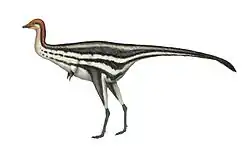
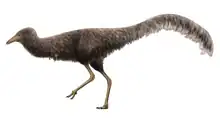
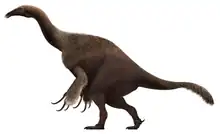
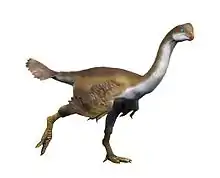
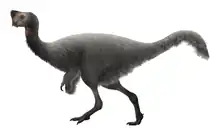
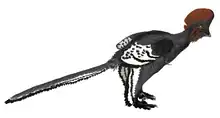


.png.webp)

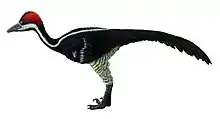
.jpg.webp)
